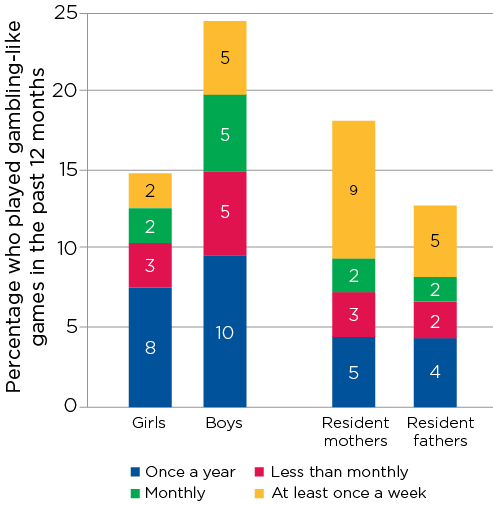Gambling Victoria Statistics
- Gambling Victoria Statistics 2019
- Problem Gambling Victoria Statistics
- Gambling Victoria Statistics Definition
1990-1991 Gaming machines appeared in Victoria. Off-course bookmakers phased out in Northern Territory. 1991-1992 Gaming machines were introduced in Queensland. Keno introduced in New South Wales, South Australia. 1992-1993 Different lotteries popped out around Western Australia. Casino Canberra opens in ACT. Introduction to Sports Gambling 1.1. Similarities and Differences Compared to Traditional Gambling Sports gambling is a form of betting similar to traditional probability games such as roulette, dice, or cards. The result of a sports bet is settled based on the.
Photo: iStock
The latest statistics on Australian gambling were released by the Queensland Government’s Statistician’s Office on 1 October 2016. Australian Gambling Statistics is a comprehensive set of statistics related to gambling in Australia that covers all legal gambling products. The Queensland Government has been compiling these stats annually since 1984, with the cooperation of all state and territory governments.
This thirty-second edition incorporates information on gambling in Australia up to and including 2014–15. It covers products such as pokies, casinos, race betting, sports betting and lotteries. Data includes total turnover, total expenditure, per adult turnover, per adult expenditure, percentage change in turnover and expenditure each year, market share of each gambling product and government revenue collected from gambling taxes.
Total losses, sports betting losses and pokies losses have risen, both nationally and in Victoria, between 2013–14 and 2014–15.
Recent research led by Deakin University’s Emily Deans on the influence of physical and online environments on wagering behaviour explored factors that may encourage risky types of betting. The team also analysed the relationship between environments and gambling consumption via in-depth, qualitative research with young male sports gamblers.
Factors identified with risky behaviour included:
- increased accessibility via mobile betting and apps, and multiple providers offering inducements to open accounts, leading to individuals having multiple accounts
- constant inducements to continue betting, delivered via apps
- a lack of a sense of reality when spending money gambling through online accounts
- the emotional appeal of gambling in groups in pubs and clubs
- being able to claim wins in cash at venues
- the role of alcohol consumption at land-based venues.
For more on this study and other research related to the risks associated with the new gambling environment, read You can get it anywhere … in this edition of Inside gambling.
Find out more
Stay informed about the latest research and statistics with our Gambling Information Resource Office’s GIRO alert.

Last updated: 08/5/2019
Author: Addictions.com Medical Review
Reading Time: 3minutes
Even without the physical triggers so commonly associated with drug addiction, gambling disorders can wreak just as much havoc in a person’s life. While drug addiction works as a substance-based disorder, gambling addictions have more to do with a lack of impulse control.
Gambling addiction often affects people who also struggle with alcohol abuse.
Ultimately, it’s the loss of control that defines addictive behavior regardless of the substance or activity involved. Gambling addiction statistics present this “loss of control” factor in a stark and alarming light.
Gambling addiction statistics show how problem gambling can up-end a person’s life in more ways than one. Not unlike other types of addiction, people most susceptible to gambling also suffer from other disorders of which they may or may not be aware.
Probably the most glaring revelation to be had from gambling addiction statistics lies in the consequences that result when gambling disorders go untreated.
1. Gambling Trends

As with all types of data, certain trends or patterns of behavior start to surface within a given population. Gambling addiction statistics are no different. Some of the more prevalent gambling trends show:
Gambling Victoria Statistics 2019
- The likelihood of developing a gambling addiction increases 23-fold for people affected by alcohol use disorders
- Over 80 percent of American adults gamble on a yearly basis
- Three to five gamblers out of every hundred struggles with a gambling problem
- As many as 750,000 young people, ages 14 to 21 have a gambling addiction
2. Gambling & Criminal Activity

As far as gambling and criminal activity goes, gambling addiction statistics reveal a direct correlation between the severity of a gambling addiction and the likelihood of committing crimes. Rates of gambling addiction for criminal offenders far exceed rates found among non-offenders. On average, an estimated 50 percent of those affected by gambling problems commit crimes in order to support their addiction.
3. College Gambling
Problem Gambling Victoria Statistics
Gambling addiction statistics show people between the ages 20 and 30 have the highest rates of problem gambling.
- 75 percent of college students report having gambled during the past year
- The risk of developing a gambling addiction more than doubles for young adults in college settings
- An estimated six percent of American college students struggle with gambling problems
4. Gambling & PTSD Trends
People affected by post-traumatic stress disorder or PTSD live with high levels of stress and anxiety on a daily basis. Gambling addiction statistics show high rates of gambling addiction among PTSD sufferers.

- PTSD symptoms affect anywhere from 12.5 to 29 percent of problem gamblers
- 34 percent of those who seek treatment for gambling addiction exhibit symptoms of PTSD
5. Gambling & Mental Illness
As addictions, in general, alter brain chemical functions in destructive ways, people struggling with gambling addiction have a higher likelihood of developing mental disorders. Gambling addiction statistics show a high incidence of certain types of mental illness, some of which include:
- Depression disorders
- Anxiety disorders
- Substance abuse disorders
- Anti-social personality disorder
Gambling Victoria Statistics Definition
As with any other type of addiction, a gambling addiction can only get worse when left untreated.